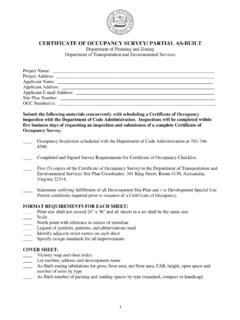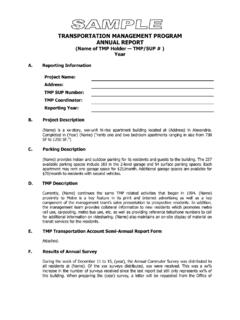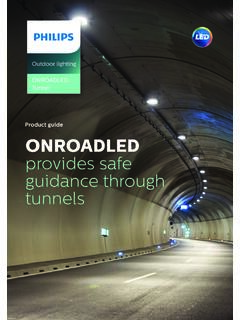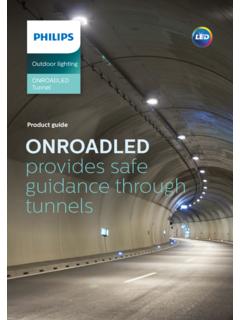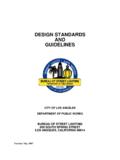Transcription of Telegraph Road Tunnel - AlexandriaVA.Gov
1 Telegraph road Tunneland Holmes Run Trail TunnelExisting Conditions and Recommendations Studyfor the City of Alexandria 1 Prepared by Toole Design Group March 20162 Telegraph RoadTunnel andHolmes Run Trail TunnelOverview3 Dimensions9 Interiors15 Lighting19 Drainage24 Entrances29 Telegraph road and Holmes Run Trail Tunnel StudyOVERVIEWThis study provides a cursory review of the pedestrian tunnels under the railroad tracks along Telegraph road near Duke Street and along the Holmes Run Trail under I-395. The study provides the location, dimensions, and a description with accompanying photos of the current materials, lighting , drainage and entrances of each Tunnel . The study provides an overview of best practices and guidelines. The study also provides general short and long term recommendations to address issues of concern and create a more welcoming and attractive space for Tunnel users. The tunnels were inspected by Toole Design Group with a focus on safety and access issues.
2 Staff visited the tunnels on Monday, January 18 and Friday, February 5, 2016 during daylight hours after a moderate rain and heavy snow respectively. During both visits the tunnels were lit. Both tunnels were being used by pedestrians. There were noticeable drainage issues, peeling paint, corrosion and dirt and debris had collected on the Tunnel addition to other guidance noted throughout the study, the following resources were used: The American Association of State Highway Transportation Officials guide for the Planning, Design, and Operation of Pedestrian Facilities (AASHTO Pedestrian guide ) The American Association of State Highway Transportation Officials guide for the Development of Bicycle Facilities (AASHTO Bike guide )3 Holmes Run Trail TunnelTelegraph road and Holmes Run Trail Tunnel StudyTelegraph road Tunnel LocationThe Telegraph road Tunnel is located between Duke Street and Mill road paralleling the east side of Telegraph road .
3 From the north side, the Tunnel is accessible via a trail that runs along Duke Street turning south to travel under (but perpendicular to) Telegraph road . From the south side, the Tunnel is accessible via Mill Tunnel travels under a series of railroad tracks and includes one windowed shaft that appear to be on the property held by the railroad. The Tunnel provides one of very few locations where pedestrians are able to cross the railroad tracks and pedestrians were seen the Tunnel during each site visit. 4 Aerial ViewMap View, courtesy of road and Holmes Run Trail Tunnel StudyHolmes Run Trail Tunnel LocationThe Holmes Run Trail Tunnel is part of Holmes Run Trail as it travels under I-395. The Tunnel is accessible on both the north and south sides via the Holmes Run Trail, which is itself accessible via neighborhood Tunnel was in continuous use by pedestrians and people on bicycle during site ViewMap View, courtesy of road and Holmes Run Trail Tunnel StudyFEMA FLOODRISKMAPS6 Telegraph road Tunnel , courtesy of FEMAH olmes Run Tunnel , courtesy of % Annual Chance Flood % Annual Chance Flood HazardTunnel LocationTelegraph road and Holmes Run Trail Tunnel StudyLANDRECORDMAPS7 Telegraph road TunnelHolmes Run TunnelGIS data, Courtesy of the City of AlexandriaTelegraph road and Holmes Run Trail Tunnel StudyWETLANDINVENTORY8 Telegraph road Tunnel , courtesy of The National Wetlands Inventory Holmes Run Tunnel .
4 Courtesy of The National Wetlands InventoryRiverineLegendFreshwater Forested/ Shrub WetlandTunnel LocationTelegraph road and Holmes Run Trail Tunnel StudyDIMENSIONSR ecommended guidelines for Tunnel height and width are provided by numerous entities. AASHTO Pedestrian Guidenotes that: Underpasses should be wide enough to invite use by all persons. The longer the Tunnel , the wider the Tunnel should be to give people a feeling of security when passing one urban areas, a desirable minimum width is 14 to 16 feet, with wider widths suggested for lengths over 60 feet. These widths also work well for bicycles on shared-use facilities. The same perception applies to vertical clearances. While an 8-foot vertical clearance can suffice for short distances, longer distance may require a vertical clearance of 10 feet or more to maintain a feeling of openness and security for Washington Metropolitan Area Transit Authority (WMATA), which designs pedestrian tunnels connecting to subway stations, recommends tunnels height be a minimum 18 feet wide for visibility and user it is likely that Virginia Department of Transportation (VDOT) would provide funding for any major Tunnel reconstruction or replacement, Tunnel dimensions should comply with VDOT s horizontal vertical clearance requirements, which are more stringent than AASHTO.
5 The VDOT road Design Manual requires 3 feet of horizontal separation between the edge of pavement and trailside obstacles ( signs). The VDOT manual also includes a 10-foot desired vertical clearance (8-foot minimum), and states that additional vertical clearance may be needed for passage of emergency or maintenance Central Station Tunnel showing separated paths for pedestrians and bicyclists. The Tunnel is 110 meters long, 10 meters wide and 3 meters high. Photo, Station Site and Access Planning Manual The AASHTO Pedestrian guide notes that the most common examples of grade-separated crossings are at freeways and railroads as is the case for the tunnels reviewed in this study. It also notes that access must be provided by a ramp that meets Americans with Disabilities Act Accessibility Guidelines. Ramps should be designed for a maximum of 5% longitudinal slope. Where switchback ramps are proposed, consideration should be given to configuration of the curves of the switchback so they can be comfortably traversed by cyclists.
6 Telegraph road and Holmes Run Trail Tunnel StudyTelegraph road Tunnel DimensionsThe Telegraph road Tunnel comprises a large-diameter corrugated metal pipe with a poured concrete floor. The trail width differs on the northern and southern ends with the change occurring at the center of the Tunnel . On the northern end, the Tunnel is elliptical in shape, with a narrower width than : 250 feetNorthern end: Trail width: feet Height: feetWidth (at widest point): feetSouthern end: Trail width: 6 feet Height: feetWidth (diameter): feet10 Telegraph road Tunnel looking 6 Telegraph road and Holmes Run Trail Tunnel StudyHolmes Run Trail Tunnel DimensionsHolmes Run Trail Tunnel includes a large-diameter corrugated metal pipe with cast concrete floor and cast concrete walls up to approximately feet in height and approximately 6 inches in depth at the base of both walls of the Tunnel . The floor is consistently 6 feet wide throughout the length of the : 300 feetTrail width: 6 feet Height: feetWidth (diameter): 10 feet, 9 inches 11 Holmes Run Trail Tunnel looking south 10 9 6 Telegraph road and Holmes Run Trail Tunnel StudyRecommendations for Increasing Tunnel Dimensions12 Short-term recommendations include:Begin preliminary discussions with rail companies Telegraph road Tunnel traverses a series of 7 active and 2 apparent inactive railroad tracks contained in an approximately 250-foot right-of-way.
7 Multiple rail companies operate in this corridor, including WMATA, Virginia Railway Express, Amtrak, and several freight rail lines including Norfolk Southern and CSX. It will be important to identify which company owns the right-of-way (thus having leasing rights), and which will have approval authority over any plans for Tunnel modifications. Rights to rail corridors are also often leased to utility companies, primarily electric and communications, because it is convenient to collocate these facilities within the uninterrupted rail corridor. It will also be important to ascertain which utilities may have facilities in the corridor that maybe impacted by Tunnel coordination with utility companies As noted above, discussions should begin with the affected utility companies as early as possible. Utility relocation is typically a long-lead-time activity (often requiring several years from initial contact to completion of relocations).
8 These utility companies typically require that relocation design and construction be performed by their own licensed consultants and contractors, and will not allow construction by the City s contractor. Early coordination will be VDOT to discuss incorporating Tunnel widening with existing or future projects VDOT s lit of upcoming projects does not currently show major work in the vicinity of either Tunnel , but there may be opportunity to reconstruct the Tunnel in conjunction with roadway improvement projects that are still several years out. Increasing Tunnel dimensions to meet design guidelines is a significant undertaking and will require complete reconstruction of the tunnels. Therefore, short-term recommendations focus on those items that that will help prepare the way for a future reconstruction, or that can be implemented to make short-term repairs to the existing tunnels. Long-term recommendations include alternatives for complete replacement of the existing Term RecommendationsDetermine remaining service life of tunnels Both tunnels are showing signs of corrosion, and structural evaluation is recommended to determine remaining service life and aid in the selection process for short-term improvements.
9 It is believed that both tunnels are currently maintained by VDOT, and recent structure inspection reports may shed some light on the condition of each Tunnel and the expected lifespan for planning Tunnel -If immediate structural rehabilitation is necessary, a cured-in-place pipe lining system is a lower-cost alternative to replacing the Tunnel , and can be performed in a very short period of time. VDOT s approved materials list includes several cured-in place pipe liner systems. Benefits of this type of system are quick installation, minimal disruption to roadway or rail operations during construction, and significant improvements to the structural stability of the tunnels. However, the pipe lining will add a 2-3-inch thick layer of material to the inside of the Tunnel , slightly reducing its diameter. In addition, treatment of the trail surface would be required to ensure a non-skid surface for pedestrians and cyclists such as concrete surface or asphalt placed over the liner.
10 Approximate costs for pipe lining are included in Appendix ATelegraph road and Holmes Run Trail Tunnel StudyRecommendations for Increasing Tunnel DimensionsLong term recommendations should focus on increasing the width and height of the tunnels, or in the case of the Telegraph road Tunnel , providing new direct and comfortable locations to cross the railroad. Innovative techniques in Tunnel construction are constantly evolving and may be applicable to either Tunnel project. In addition, hand-digging is still a commonly used technique. All alternatives would require right-of-way acquisition; formal abandonment (and likely filling) of the existing Tunnel ; consideration of environmental and utility impacts, and drainage. Alternatives for replacing each Tunnel include:Reconstruct Larger TunnelsReplacement of the Telegraph road Tunnel involves the added complexity of constructing the Tunnel under an active railroad right-of-way.




